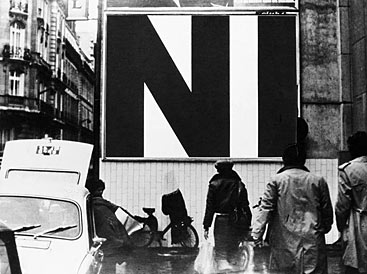
Born in 1942 in Paris (FR)
Lives and works in Paris (FR)

1977-1978
Silkscreen printing poster
4 x 3 m
Year of Purchase: 1995
‘An art which has not made its way into life will be inventoried at the archaeological museum of antiquities.’ Rodchenko
Tania Mouraud is recalcitrant, involved and stubborn. She embarked on her career as an artist in the late 1960s, in Paris, where she still lives and works today. Since her first installation at the Galerie Rive Droite in 1970, her work has cultivated powerful references to conceptual art, whereby the work of art is merely the transmission of an idea or an image of thought, with no material quality and no commercial value any more. This desire to break out of the art system, where the discourse and commercial concerns keep the spectator at a distance is one of the main themes of Tania Mouraud’s work.
‘I have stated my absolute disagreement with the western ideology based on having by scattering a word—“NI” (meaning neither or nor)-measuring 3 by 4 metres on 54 advertisement hoardings all over Paris.’
Rightly regarded as an anthological work of late 1970s’ art, the ‘NI’ series, written in gigantic letters, is the denial of patterns of behaviour brought on by a post-industrial society where consumerism goes hand in hand with illusion. By using a simple and direct formulation, the serial work achieves its goal. ‘I like using minimal means for maximum effectiveness.’
The ‘NI’ series is the ultimate negation, absolute truth; it is monumental typography in a site of futile writing; it invites passers-by to take charge of their dreams, and question their real space of freedom.
The use of language as a material as well as the idea of an environmental praxis has led Tania Mouraud to a conception that people like to call ‘social art’ or ‘political art’. ‘If political means questioning reality, exposing prejudices, keeping tabs on ideology, developing reality, then my work is essentially political.’
But her work goes well beyond this analysis, and makes its way through lines of thought peculiar to the 20th century’s avant-gardes. By leaving the illusionistic space of painting to enter straight into real space, by not confining herself to a single language, by using the coded systems of advertising and art, by shattering the uniqueness of the work, by developing her activities in a transversal way between art genres and art arenas, Tania Mouraud has constructed a an oeuvre that chips away at, and undermines, things—an oeuvre that younger generations cannot easily ignore.
As a sign of the times, like other women—Barbara Kruger and Jenny Holzer to name just two—Tania Mouraud has used the public place and thus enlarged the area assigned to art, perhaps because art galleries and museums, which are notoriously narrow-minded, are essentially earmarked for men.
Béatrice Josse
Move out of the gallery, the museum, the obvious places. Accept the rules of the street: legibility = redundancy. Dot the urban space with 54 signs, establishing a network that can reach motorists through ‘road-blocks’ on traffic routes, and also pedestrians, those who never get out of their own neighbourhood: housewives, children, old people; knowing from the outset that the dice are loaded.
For Paris, 200 posters are needed for minimal legibility. To come despite everything, one year later, in memory tests, in second place behind Chaumes cheese (400 posters = 45%). NI 54 posters = 37% memorization. Astonishment of the advertising people, as in terms of communication, only the target audience remembers.
NI, an operation with no follow-up, no teasing, no hidden publicity from the Ministry of Culture. Just anonymous position-taking. Ultimate negation, absolute truth, universal circuit-breaker used by Western logicians and Eastern sages.
NI (neither/nor): NEITHER white NOR non-white NOR black NOR non-black. So 37% of the population of Paris are concerned by this 3m x 4m message? Despite plenty of media coverage (TV, radio, press), apparently total lack of feedback, in contrast with closed-circuit operations. A few chance encounters: a photographer sending snapshots to Japan. A customs officer who each day asked himself questions on this NI, readable as such in the street. Only the diagonal conveys meaning, and outside of a public of people in the know, very few people accept forms for what they are. They must necessarily make reference to something. NI, printed in black and white (forbidden by law) because the text could pass for an image. NI, monumental typography in a place usually reserved for futile writing; they invite passers-by to take charge of their dream, to get away from compulsory consumer places, the first stage towards total discrimination.
Tania Mouraud